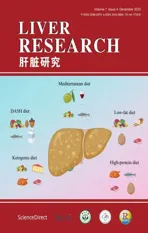Mutation of autophagy-related gene ATG7 increases the risk of severe disease in patients with non-alcoholic fatty liver disease☆
2023-12-29MaryMiuYeeWaye
Non-alcoholic fatty liver disease (NAFLD) is the most common chronic liver disease worldwide.The mechanism of NAFLD has been well studied and it has been previously reported that there are some predisposing genetic polymorphisms of NAFLD,e.g.,genes such as fat mass and obesity-associated(FTO)overexpression,leading to triglyceride accumulation,via upregulation of lipogenic genes has been reported.1An earlier study of a 20-gene set published in 2014 has been correlated with NAFLD severity.2Adiposity plays an important role in the amplification of the genetic risk of NAFLD -including three variants: PNPLA3,TM6SF2,and GCKR genes.3
Clinicians routinely classify patients with NAFLD into those at high-versus low-risk for eventual liver-related morbidity and mortality based on the severity of liver fibrosis,and any biomarkers that could aid with the prognosis of NAFLD would be very useful in the development of novel clinical management strategies.Recently,a study using the modern technology of second-generation sequencing,i.e.,whole-exome sequencing in individuals with NAFLD and advanced fibrosis or hepatocellular carcinoma (HCC)was published.4
The participants included the EPIDEMIC cohort which included 72 Italian patients with NAFLD-HCC,59 Italian patients with severe fibrosis (stage F3-F4),and 70 patients with NAFLD-HCC from the United Kingdom (UK).Furthermore,the clinical samples gene frequencies were compared to the general population (n=56,885,the Genome Aggregation Database (gnomAD) non-Finnish Europeans plus 50 local ethnically matched healthy individuals from the same geographical area) for the Discovery cohort and to European individuals without liver disease included in UK Biobank for the Validation cohort (n=123,456).
The results indicated that mutations in theATG7C-terminal catalytic domain were consistently enriched in all clinical cohorts and having at least 1 rare variant in theATG7C-terminal domain was associated with a 13.9 increase in the risk of severe NAFLD,and there is a consistent enrichment inATG7variants for all case cohortsvs.controls.Of particular interest is that the 3:g.11389502C>T rare variant ofATG7(P426L,MAF of 0.0017),conferred a large,greater than 7-fold,increase in the risk of severe liver disease in European individuals.The authors proposed that the loss of function (LoF) or deleterious missense mutations could lead to a reduction in autophagy and the accumulation of lipids in hepatocytes.
To illustrate the biological function of the different variants of theATG7genes,transfection of the gene was performed and the outcome was measured by the level of the intracellular neutral lipid contents of HepG2 and HepaRG hepatocyte cultured in oleic acids.Furthermore,ATG7silencing (using siRNA) increased intracellular lipid accumulation in primary human hepatocyte cultures (both 2D and 3D cultures).ATG7knockdown using siRNA resulted in lipid overload in human hepatoma cells,whileATG7overexpression rescued the intracellular lipid accumulation.The protein coded by ATG7 (by immunohistochemical staining) in liver biopsies was also analyzed to test the correlation of ATG7 protein and hepatocellular ballooning or S3 steatosis (Fig.1).Transcriptomics analyses were also performed to illustrate thatATG7expression level was positively correlated with that of genes involved in several metabolic pathways,the mechanistic target of rapamycin complex 1(mTORC1)signaling and coagulation,cell cycle progression and tumor necrosis factor alpha (TNFα) signaling.There is an increase in expression levels of the autophagy genes upstream ofATG7,while most of the genes downstream ofATG7were downregulated suggesting an interruption of the pathway at this level.

Fig.1.Hypothetical model of NAFLD due to mutation of the ATG7 gene.Rare and low-frequency ATG7 loss of function variants (p.P426L,rs143545741 C>T;p.V471A,rs36117895 T>C)that potentiate NAFLD progression by impairing autophagy and facilitating hepatocellular ballooning and inflammation.Abbreviation:NAFLD,non-alcoholic fatty liver disease.
In this study,the association effect size ofATG7variants was amplified by the presence of obesity,resulting in a 23-fold higher risk of HCC in obese individuals.Their histological findings using patients’ biopsies with correlates ofATG7p.V471A andPNPLA3p.I148 M are consistent with the report that the combination of LoF ofATG7withPNPLA3p.I148 M -a major modifier of hepatic lipid droplet remodeling -has a synergic impact on liver disease and results in decreased starvation mediated lipid-droplet autophagy.5,6This study is also consistent with the finding that hepatocyte-specific deletion of Atg7 promotes an increase in liver weight of up to 8.5 times,fibrosis,progenitor cell expansion,and hepatocarcinogenesis.7Furthermore,families with deleterious ATG7 mutations had complex neurodevelopmental disorders with brain,muscle,and endocrine involvement,pointing out the debilitating consequences of deficiency in the autophagy degradation pathway.8Thus,mutations of the ATG7 gene could be sufficient to increase the incidence of fibrosis and non-alcoholic steatohepatitis (NASH).By knowing the mechanisms of severe NAFLD,one could eventually discover drugs to halt liver fibrosis and injury.For example,the finding of an antibody that could inhibit TNFR1 resulted in significant improvement in insulin resistance,apoptotic liver injury,liver fibrosis,as well as alanine aminotransferase levels.9Such susceptibility genes would be helpful in finding those with a high risk for bad NAFLD outcomes that could mean worse liver injury and more fibrosis (severe NAFLD).
To sum up,this study reported that rare and low-frequency LoF of geneticATG7variants could act as modifiers of NAFLD progression in Europeans and future studies of rare genetic variants can be used to identify novel candidate genetic determinants of human diseases.
Author's contributions
Mary Miu Yee WAYE conceived the project,wrote,critically reviewed,and edited the manuscript.
Declaration of competing interest
The author declares that there is no conflicts of interest.
Acknowledgements
This manuscript was not supported by any funding.
杂志排行
Liver Research的其它文章
- Dietary pattern and hepatic lipid metabolism☆
- In-depth analysis of de novo lipogenesis in non-alcoholic fatty liver disease: Mechanism and pharmacological interventions☆
- The contributions of bacteria metabolites to the development of hepatic encephalopathy☆
- Autophagy modulates physiologic and adaptive response in the liver☆
- Hepatocellular carcinoma recurrence: Predictors and management☆
- Unveiling the effect of estrogen receptors in alcoholic liver disease:A novel outlook☆
